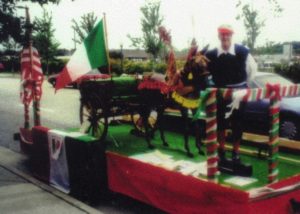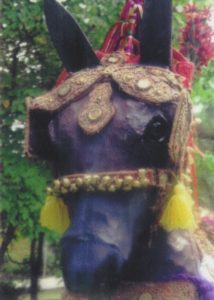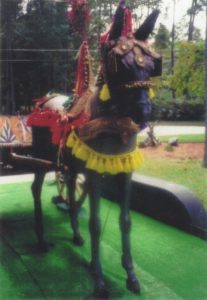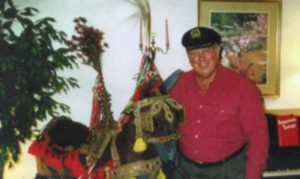Frank DiCristina (1920 – 2015) took great pride in being Italian and, especially, Sicilian. A man rich in character and personality, Frank was  extremely proud of his family and their Sicilian heritage, his Catholic faith, andhismilitary service. His family was his most valued treasure, and he lived by the words “tutta la famiglia.” Frank grew up in Atlanta, GA, in the Catholic Italian community, and his love of heritage and faith followed him throughout his life. While living and working in Fayetteville, NC, he was very involved in the Sons of Italy and was recognized for numerous achievements. Although he passed away in 2015 at the age of 95, he once had a love in his life that he cherished as much as his family. She was a wooden donkey named Gina.
extremely proud of his family and their Sicilian heritage, his Catholic faith, andhismilitary service. His family was his most valued treasure, and he lived by the words “tutta la famiglia.” Frank grew up in Atlanta, GA, in the Catholic Italian community, and his love of heritage and faith followed him throughout his life. While living and working in Fayetteville, NC, he was very involved in the Sons of Italy and was recognized for numerous achievements. Although he passed away in 2015 at the age of 95, he once had a love in his life that he cherished as much as his family. She was a wooden donkey named Gina.
Frank frequently related the story of the Carretto Siciliano that was a long-time mystery in Fayetteville, NC. No one knew how the community came to own the cart. It was in a storage room, and most citizens of the town did not even know what it was or what it represented. They put it on display in 1980, not knowing the origin. In 1992, it was again on display at the Fayetteville Art Council. In 1995, it was back in storage, disassembled.
In June of 1995, the Sons of Italy, realizing the significance of the cart, wanted to bring it to life by making a donkey to ‘pull’ it, thus making a complete unit. It was to be shown in the 1995 Folk Festival Parade.
Frank decided to take things into his own hands. He was a retired salesman who loved building things, especially model airplanes. He said, “After much research, I drew the plans for the donkey and transferred the information to actual size. Templates were cut out of plywood, creating the framework for the project. When the ribs were attached to the body, each rib section was covered by stapling with a piece of chicken wire. When everything was in place, the entire body was covered with burlap with a combination of stapling and gluing with a glue gun. The  burlap was first painted with two coats primer followed by two coats of latex in the proper color. The eye sockets were made with rope, which gave depth to the eyes. The eyes were deer eyes from a taxidermist.”
burlap was first painted with two coats primer followed by two coats of latex in the proper color. The eye sockets were made with rope, which gave depth to the eyes. The eyes were deer eyes from a taxidermist.”
Frank labored for 30 days and delivered the donkey, which he named Gina. A harness was imported from Sicily and was accented with tassels and plumes by Italian Lodge member Rome Zahran. This was then attached to the donkey, and the donkey to the cart to make it complete.
 The cart and donkey were placed on a float and shown in the 1995 Fayetteville Folk Festival Parade. Children rode in the cart dressed as aSicilian bride and groom. After the Festival was over, Gina and the cart were supposed to be displayed in a city museum. When the museum decided they only had space for the cart, Frank took his lovely Gina to his own home where she held an honored place in his living room next to the piano.
The cart and donkey were placed on a float and shown in the 1995 Fayetteville Folk Festival Parade. Children rode in the cart dressed as aSicilian bride and groom. After the Festival was over, Gina and the cart were supposed to be displayed in a city museum. When the museum decided they only had space for the cart, Frank took his lovely Gina to his own home where she held an honored place in his living room next to the piano.
